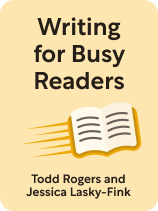

This article is an excerpt from the Shortform book guide to "Writing for Busy Readers" by Todd Rogers and Jessica Lasky-Fink. Shortform has the world's best summaries and analyses of books you should be reading.
Like this article? Sign up for a free trial here.
Do you know how to get your point across in writing? Is long-form or short-form writing more effective? What should be in your CTA?
In Writing for Busy Readers, authors and behavioral scientists Todd Rogers and Jessica Lasky-Fink teach you how to clearly get a point across. They argue that clarity, conciseness, and simplicity are key factors.
Here are two important things to keep in mind when you’re trying to make a point.
Tips for Crafting a Clear Message
As you write, focus on getting your point across as clearly as possible. Rogers and Lasky-Fink reiterate that if you confuse your readers, you risk losing their attention or causing them to misinterpret your message. To write clearly, aim for concision and simplicity. Let’s explore each of these concepts in more detail.
1. Writing Concisely
The authors say that to keep your readers’ attention and drive your point home, you should write concisely. They explain that many writers conflate wordiness with expertise—you may feel you need to write down everything you know about your topic to convince readers that you’re knowledgeable about it. However, readers are often put off by lengthy content since it requires more time and effort to read. They might start reading long-form content, but they’re less likely to read it all the way through. Additionally, it’s easier for readers to lose sight of key takeaways if you distract them with tangential information.
(Shortform note: Rogers and Lasky-Fink argue that readers are more likely to engage with concise writing than longform content, and some evidence supports this: Our attention spans are markedly shorter than they used to be, which may explain the rise of platforms like TikTok that deliver bite-sized content. However, some experts say long-form content is poised to make a comeback. Research suggests that audiences distrust overly simplified content and are increasingly seeking in-depth analysis from credible sources—especially on complex or controversial topics where nuance matters.)
So, how can you write concisely? Rogers and Lasky-Fink explain that you should write as little as possible. Start by zeroing in on the main takeaway or takeaways you want to express, and omit tangential information and fluffy asides. Then, as you write about these takeaways, express your ideas succinctly. Use precise language, avoid redundancy, and eliminate unnecessary words or phrases while ensuring your message remains clear and complete.
(Shortform note: To write more concisely, take a cue from short story writers like Raymond Carver who eschew adjectives and adverbs. Adjectives are words that describe nouns, like beautiful or bright. Adverbs like quickly and very modify verbs. Avoid these unless they’re essential to clarify your meaning; instead, rely on powerful verbs and precise nouns that convey your message on their own. For example, instead of writing, “He walked very slowly,” try a variation like “He trudged” or “He crept.” These verbs are both vivid and efficient.)
2. Writing Simply
In addition to writing concisely, Rogers and Lasky-Fink say you must write simply. Use straightforward language that readers can understand without consulting a dictionary. For example, instead of writing, “Cardiothoracic complications may necessitate immediate medical intervention,” opt for a simpler alternative like “Heart or lung problems may need quick treatment.” The authors explain that readers are more likely to engage with and fully understand your message if you frame it in simple language. In contrast, complex writing is easily misunderstood and mentally taxing to process, which leads readers to lose interest (especially when they’re pressed for time).
| Writing Simply Means Writing Plainly If you struggle to write simply, you might benefit from reading the US government’s plain language guidelines. These guidelines were developed to help federal officials communicate clearly with the public, as required by the Plain Writing Act of 2010 (though many government institutions don’t comply). Using plain language makes your writing more inclusive and easier to understand, especially for people with lower literacy levels, cognitive differences, or—as Rogers and Lasky-Fink note—limited time. It also makes your writing easier to translate into other languages. Some examples of plain language guidelines include: Use the same terms consistently: While using synonyms might seem like a good way to avoid repetition, it can confuse readers. Stick to one term to help readers follow along. For example, always refer to “project managers” as such—don’t switch to “supervisors” or “directors.” Use active voice: Passive voice can make writing harder to understand. Instead of writing, “The policy was implemented by the committee,” write, “The committee implemented the policy.” Use contractions: Contractions like “don’t,” “can’t,” and “it’s” are more conversational than “do not,” “cannot,” and “it is,” which makes your writing feel more accessible. They can also shorten sentences, which contributes to clarity and ease of reading. |
Include a Call to Action
Once you’ve written a clear message to your readers, include a call to action (CTA): a stimulus that prompts readers to perform a specific action. Rogers and Lasky-Fink note that CTAs aren’t always appropriate; for example, if your goal is simply to inform your audience about new research findings, you probably don’t need a CTA. But if you want to encourage readers to sign a petition, follow public health guidelines, or buy a product, a clear CTA can motivate your audience to take that action when they finish reading your content.
If you decide to include a CTA, Rogers and Lasky-Fink recommend that you make it as easy as possible for readers to perform the desired action by reducing the mental load of 1) deciding to act and 2) following through. For example, instead of giving readers a menu of choices regarding subscription plans, offer them a pre-selected option based on their preferences or needs. Readers are more likely to perform a one-step action like pressing a button to sign up for a subscription than a multistep process that includes deciding which subscription plan is best for them, creating an account, and confirming their selection.
| When and How to Write a CTA Rogers and Lasky-Fink note that if your goal is only to inform your readers, you don’t need to include a CTA. However, informative writing often has a secondary goal to inspire or encourage a certain response. For example, if you write an article about how to live an eco-friendly lifestyle, you probably hope your audience will act on the information you give them, so you might include a simple CTA like “Try switching to reusable grocery bags this week.” If you decide your content needs one, follow these tips for writing effective CTAs: Be specific and action-oriented: Vague CTAs like “Learn more” or “Get involved” don’t give readers a clear idea of what to do next. Instead, use precise language that tells them exactly what step to take. For instance, “Download the recycling checklist” or “Sign the clean energy petition” gives a clear directive and helps remove hesitation. Make the benefit clear: Explain why taking the action will be worthwhile for the reader. If they understand what’s in it for them, they’re more likely to follow through. For example, instead of saying “Subscribe to our newsletter,” try “Subscribe to get weekly tips on reducing your carbon footprint.” Insert multiple CTAs: Many writers only place the CTA at the end of their writing because it feels like a natural conclusion—but readers often don’t make it that far. To increase the chances that your audience will take action, include CTAs at key points throughout your piece, especially after making a strong argument or presenting compelling information. These CTAs can be subtle nudges (“Click here to learn more”) or bold directives (“Sign up now to get started”). |

———End of Preview———
Like what you just read? Read the rest of the world's best book summary and analysis of Todd Rogers and Jessica Lasky-Fink's "Writing for Busy Readers" at Shortform.
Here's what you'll find in our full Writing for Busy Readers summary:
- Why some writers are so successful at connecting with readers while others aren't
- How to make your writing more impactful and increase your reach
- That how you communicate can be just as important as what you say






